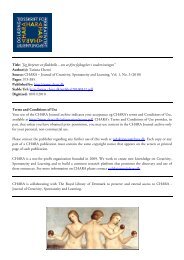VOL 2 Indholdsfortegnelse - Chara - Tidsskrift for kreativitet ...
VOL 2 Indholdsfortegnelse - Chara - Tidsskrift for kreativitet ...
VOL 2 Indholdsfortegnelse - Chara - Tidsskrift for kreativitet ...
Create successful ePaper yourself
Turn your PDF publications into a flip-book with our unique Google optimized e-Paper software.
Nancy Siegel<br />
____________________________________________________________________________<br />
After all my searching, I have learned that the imposed silence that I suffered is the shadow side of<br />
a very beautiful and rich silence, a positive place that has the potential to create something from<br />
nothingness. Choosing silence versus being silenced or stumbling upon it, can be healing, expansive,<br />
and instructive. Being silenced, on the other hand, is crippling, belittling, constricting, and<br />
disempowering. (LeClaire, 2009, 84, 88.)<br />
As an adult in mid-life and no longer a scared, traumatized nine-year-old, silence is a very much<br />
welcomed part of my life. As an educator and mother of four, I have embraced silence as a<br />
wonderful place, a beautiful space offering a meaningful and nurturing opportunity. Silence has<br />
become my friend and I look at it with awe and admiration. I see it as a vehicle of richness, a place<br />
of depth and value. An incubator where creativity can be nourished and birthed. It is a perfect<br />
and optimal environment <strong>for</strong> nurturing and fostering creative expression. It is in the emptiness of<br />
silence that I have come to see vastness and silence has incubated much of my own creative<br />
expression.<br />
In Listening Below the Noise Anne LeClaire talks about the connection between silence and<br />
creativity “Early on I discovered that there is a direct correlation between quiet and creativity. In the<br />
space of silence, ideas can surface and connections can be made. All distractions distort and ultimately<br />
destroy creativity, noise most of all. And, of course, on the most basic level, silence is enormously restful to<br />
both body and mind and that frees up energy to create.” (LeClaire, 2009, 84)<br />
The German philosopher, Max Picard, who has written extensively on silence, says that “silence is<br />
nothing merely negative; it is not the mere absence of speech. It is a positive, a complete world in<br />
itself.” (Picard, 1945, 132)<br />
This positive “complete world” is a quiet space <strong>for</strong> reflection and depth and richness. As Picard<br />
says, it is not just the absence of sound or words. It is a mindful intentional silence, one that offers<br />
a quiet place <strong>for</strong> reflection. It is the place deep inside us that offers stillness and calm, that allows<br />
<strong>for</strong> a journeying inward away from the outside world.<br />
Daniel Siegel, psychiatrist and scientist, writes in his book The Mindful Brain that when a mind is<br />
mindful and receptive to all that arises in silence, an active engagement can occur; an active<br />
engagement with the environment through the senses which allows <strong>for</strong> a connection to the self.<br />
Siegel talks about the silence that allows <strong>for</strong> stillness of the brain. “Why silence?” he asks. “Silence<br />
creates a rare opportunity to pause and drop into stillness, to become intimate with your own mind.<br />
When we start the journey to attune to our own minds by pausing into stillness we enter a new realm of<br />
____________________________________________________________________________<br />
226 ISSN 1904-2078 <strong>Tidsskrift</strong> <strong>for</strong> <strong>kreativitet</strong>, spontaneitet og læring



